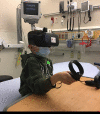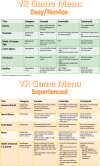Virtual reality-based distraction for intravenous insertion-related distress in children: a study protocol for a randomised controlled trial
- PMID: 35354617
- PMCID: PMC8968513
- DOI: 10.1136/bmjopen-2021-057892
Virtual reality-based distraction for intravenous insertion-related distress in children: a study protocol for a randomised controlled trial
Abstract
Introduction: Intravenous (IV) insertions are among the most performed procedures for children seeking medical care; they are often a painful and stressful experience for both children and their caregivers. Paediatric distress and pain that is inadequately treated may lead to a frightened and uncooperative child, repeated IV attempts and overall frustration with care for both the family and clinical team. We hypothesise that distraction via an immersive virtual reality (VR) experience may reduce the associated distress for children undergoing IV insertions.
Methods and analysis: This two-armed randomised controlled superiority trial will be conducted in a Canadian paediatric emergency department and will aim to enrol 80 children overall. Children will be randomised to receive either departmental standard of care alone or standard of care plus an immersive VR experience. Children 6-17 years of age who are undergoing IV insertion and have topical anaesthetic application will be considered for inclusion. Our primary objective is to compare the reduction of distress between the two study arms. The primary outcome will be the child's observed distress score as measured by the Observational Signs of Behavioral Distress-Revised tool. Secondary outcomes include the child's pain intensity and fear, parental anxiety, satisfaction with the IV procedure, as well as adverse events. Recruitment launched in September 2020 and is expected to end in March 2022.
Ethics and dissemination: This study has been approved by the Health Research Ethics Board (University of Alberta). Informed consent will be obtained from parents or guardians, and assent from children. Study data will be submitted for publication irrespective of results. This study is funded through a Women and Children's Health Research Institute Innovation grant. Purchase of the VR equipment was facilitated through a Stollery Children's Hospital Foundation small equipment grant.
Trial registration number: NCT04291404Cite Now.
Keywords: ACCIDENT & EMERGENCY MEDICINE; PAIN MANAGEMENT; Paediatric A&E and ambulatory care; Pain management.
© Author(s) (or their employer(s)) 2022. Re-use permitted under CC BY-NC. No commercial re-use. See rights and permissions. Published by BMJ.
Conflict of interest statement
Competing interests: None declared.
Figures



Similar articles
-
Study protocol for a randomised controlled trial of humanoid robot-based distraction for venipuncture pain in children.BMJ Open. 2018 Dec 14;8(12):e023366. doi: 10.1136/bmjopen-2018-023366. BMJ Open. 2018. PMID: 30552264 Free PMC article. Clinical Trial.
-
Guided relaxation-based virtual reality versus distraction-based virtual reality or passive control for postoperative pain management in children and adolescents undergoing Nuss repair of pectus excavatum: protocol for a prospective, randomised, controlled trial (FOREVR Peds trial).BMJ Open. 2020 Dec 30;10(12):e040295. doi: 10.1136/bmjopen-2020-040295. BMJ Open. 2020. PMID: 33380482 Free PMC article.
-
The VRIMM study: Virtual Reality for IMMunisation pain in young children-protocol for a randomised controlled trial.BMJ Open. 2020 Aug 20;10(8):e038354. doi: 10.1136/bmjopen-2020-038354. BMJ Open. 2020. PMID: 32819997 Free PMC article.
-
The effect of virtual reality versus standard-of-care treatment on pain perception during paediatric vaccination: Study protocol for a randomised controlled trial.J Clin Nurs. 2025 Mar;34(3):685-696. doi: 10.1111/jocn.17395. Epub 2024 Aug 6. J Clin Nurs. 2025. PMID: 39107891 Review.
-
Use of virtual reality in managing paediatric procedural pain and anxiety: An integrative literature review.J Clin Nurs. 2022 Nov;31(21-22):3032-3059. doi: 10.1111/jocn.16217. Epub 2022 Jan 23. J Clin Nurs. 2022. PMID: 35068011 Review.
Cited by
-
Pain Management in Children Admitted to the Emergency Room: A Narrative Review.Pharmaceuticals (Basel). 2023 Aug 18;16(8):1178. doi: 10.3390/ph16081178. Pharmaceuticals (Basel). 2023. PMID: 37631093 Free PMC article. Review.
-
Office-based sedation-free transnasal esophagogastroduodenoscopy with biopsies using single-use gastroscopes: A pediatric single-center experience.JPGN Rep. 2023 Dec 20;5(1):29-34. doi: 10.1002/jpr3.12025. eCollection 2024 Feb. JPGN Rep. 2023. PMID: 38545271 Free PMC article.
References
Publication types
MeSH terms
Associated data
LinkOut - more resources
Full Text Sources
Medical
